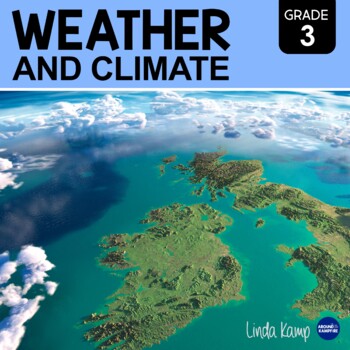Weather & Climate Third Grade Science Unit NGSS
- Zip
What educators are saying
Also included in
- This third grade weather and climate bundle is a comprehensive science resource carefully designed with literally everything you need to teach NGSS, TEKS, and many state science standards for weather and climate. Each ready-to-teach lesson comes with an instructional PowerPoint, detailed, scripted lPrice $28.00Original Price $36.00Save $8.00
- Teaching third grade science, aligned the Next Generation Science Standards, is quite challenging without quality resources to guide you. These in-depth science units address all the 3rd grade NGSS topics and enable you to plan and teach highly-engaging lessons that don’t take hours to plan becausePrice $106.00Original Price $132.00Save $26.00
Description
This third grade weather and climate unit is a comprehensive science resource carefully designed with literally everything you need to teach NGSS, TEKS, and many state science standards for weather and climate.
This unit is also available in a money-saving bundle with digital activities and audio lessons CLICK HERE.
Each ready-to-teach lesson comes with an instructional PowerPoint, detailed, scripted lesson plans, response journal activities, differentiated quizzes, hands-on investigations and simple lab activities that are actually do-able in your classroom.
The lessons also include vocabulary posters, guiding questions, and learning objectives display cards as well as related videos for each lesson. Literacy and math-based science centers make it easy to integrate science during your reading and math blocks if you wish to.
Science and engineering practices are woven into each lesson as students investigate real-world phenomena that require them to design solutions to weather-related problems.
This third grade weather unit is the second unit in the third grade science series. It includes 20 days of complete science lessons on weather, climate zones, seasonal weather changes, weather instruments, the water cycle, measuring temperature, comparing weather data, and more! These lessons will have your students begging you for science!
Assessing each lesson is easy to differentiate using one of two quiz formats: the fill-in-the-blank option or the short, written response format. At the end of the unit, students are assessed with a comprehensive unit test with questions modeled after standardized tests that allow students to practice important skills while you assess learning.
What’s included:
- A complete Teacher’s Guide with a 22-day Pacing Guide that can be shortened to fit your schedule
- Standards alignment pages with NGSS, TEKS, and CCSS for each lesson
- Teacher planning binder with cover and sections
- 22 Days of detailed, scripted lesson plans.
- 8 Hands-on investigations with guided lab procedures and step-by-step directions with photos.
- 8 Partner activity labs
- An in-depth Teaching PowerPoint to guide you through 22 engaging lessons with Turn and Talk partner discussion, Independent Activity slides, and a slide introducing the Investigation for each lesson
- Science focus wall with essential question posters and learning target cards
- Student science journal booklet with activity pages to reinforce each lesson
- Vocabulary cards + full-page vocabulary posters
- Quick Check/Exit Tickets in 2 formats for each lesson (short written response or fill in the blank) with answer keys
- Final Unit Test & Answer Key
- 4 Literacy and math-based science centers
- Related videos for each lesson
- Weather and climate book list
- BONUS Weather bulletin board set
Lesson topics:
· Lesson 1.1 Water and Weather
· Lesson 1.2 Impacts of Weather
· Lesson 1 Lab: How can water and temperature damage a home?
· Lesson 2.1 Seasonal Weather Changes
· Lesson 2.2 Weather Instruments
· Lesson 2.3 Measuring and Comparing Temperature
· Lesson 2 Lab: Designing Tools to Measure Rainfall
· Lesson 3.1 Hazardous Weather
· Lesson 3.2 Flood Simulation
· Lesson 3 Lab: Reduce the Impact of a Hurricane
· Lesson 4.1 Climates on Earth
· Lesson 4.2 How do mountains affect climate?
· Lesson 4.3 Climate Zones
· Lesson 4 Lab: Model how sunlight varies on Earth
· Lesson 5.1 Factors That Affect Climate
· Lesson 5.2 Climate Change
· Lesson 5.3 The Greenhouse Effect
· Lesson 5 Lab: Investigate Sea Level Rise
Please download the Preview for more details and pictures of everything included plus a list of the easy-to-find materials needed for the experiments.
Click here to download a Lab Materials List.
Happy teaching!
Linda Kamp
Around the Kampfire
Click here for all 3rd grade units and bundles.
Additional units in this series:
Scientists & The Scientific Method
Environment, Survival & Fossil Evidence
Third Grade Science Yearlong BUNDLE
Click HERE for DIGITAL science units
Click HERE for 2nd grade science units.







